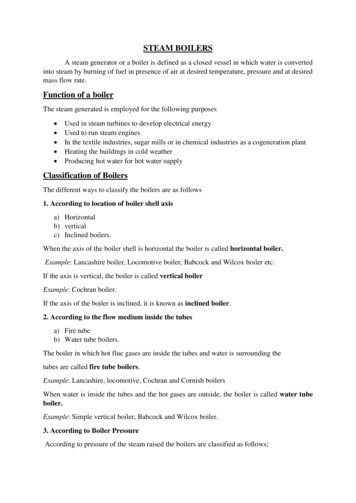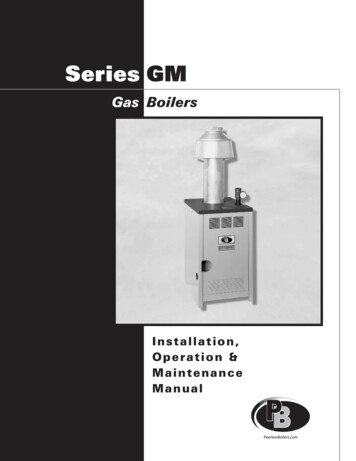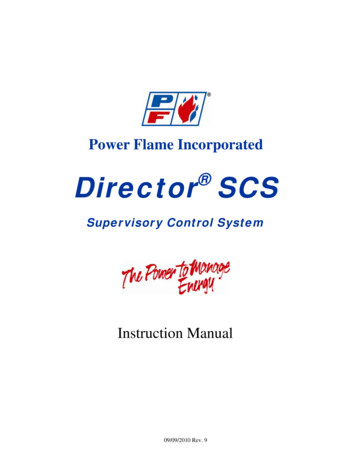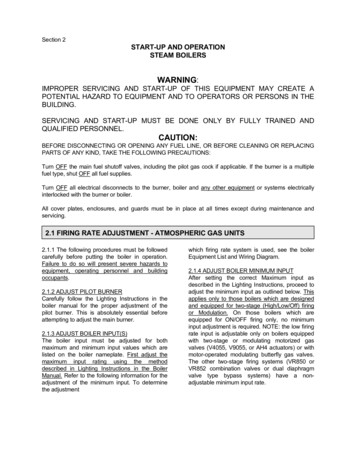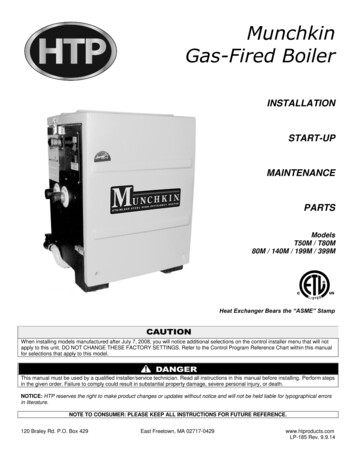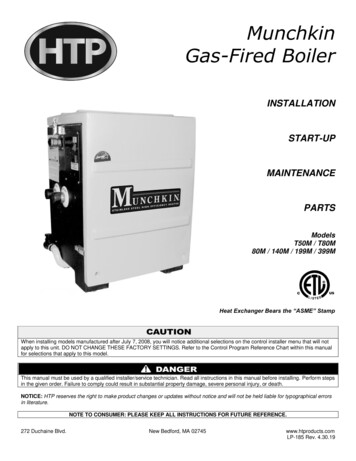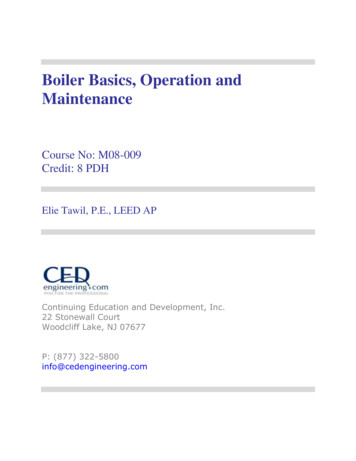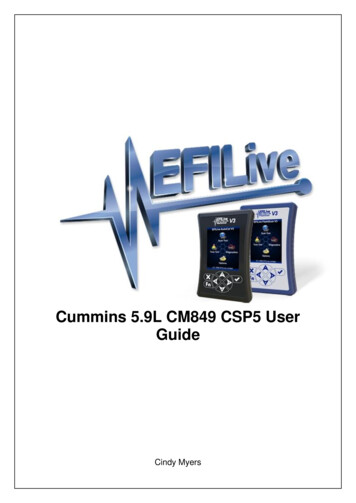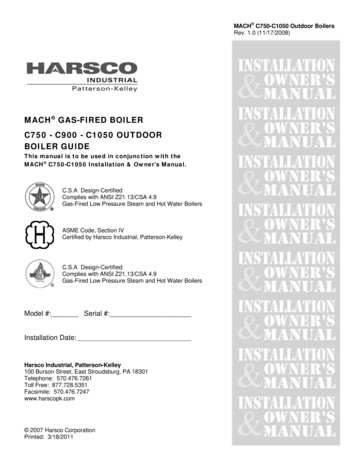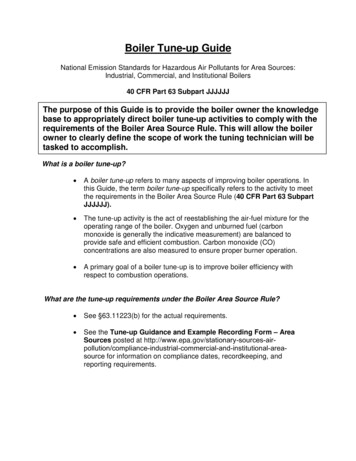
Transcription
Boiler Tune-up GuideNational Emission Standards for Hazardous Air Pollutants for Area Sources:Industrial, Commercial, and Institutional Boilers40 CFR Part 63 Subpart JJJJJJThe purpose of this Guide is to provide the boiler owner the knowledgebase to appropriately direct boiler tune-up activities to comply with therequirements of the Boiler Area Source Rule. This will allow the boilerowner to clearly define the scope of work the tuning technician will betasked to accomplish.What is a boiler tune-up? A boiler tune-up refers to many aspects of improving boiler operations. Inthis Guide, the term boiler tune-up specifically refers to the activity to meetthe requirements in the Boiler Area Source Rule (40 CFR Part 63 SubpartJJJJJJ). The tune-up activity is the act of reestablishing the air-fuel mixture for theoperating range of the boiler. Oxygen and unburned fuel (carbonmonoxide is generally the indicative measurement) are balanced toprovide safe and efficient combustion. Carbon monoxide (CO)concentrations are also measured to ensure proper burner operation. A primary goal of a boiler tune-up is to improve boiler efficiency withrespect to combustion operations.What are the tune-up requirements under the Boiler Area Source Rule? See §63.11223(b) for the actual requirements. See the Tune-up Guidance and Example Recording Form – AreaSources posted at l-areasource for information on compliance dates, recordkeeping, andreporting requirements.
Who should perform the actual tune-up? All boiler adjustments and modifications should be completed by qualified,experienced technicians. Boiler operations in general and tune-up activities in particular arehazardous and require the skill and knowledge of experiencedtechnicians. The tune-up technician should be skilled in the evaluation and adjustmentof the specific boiler and burner equipment in use.What are the basic activities and minimum requirements associated with a boilertune-up?The following is a simple checklist that highlights the basic activities andrequirements associated with a boiler tune-up to comply with the requirements of theBoiler Area Source Rule. The checklist is intended to be a time ordered tool to aid inplanning and conducting boiler tune-ups.1) Preparationa) Clearly identify the target equipment along with the intent and goals of the tuneup.b) Assemble boiler drawings and data sheets.c) Assemble burner drawings and data sheets.d) Assemble combustion control information.e) Identify environmental regulations and limitations.i) Typically nitrogen oxides (NOx) and combustible material (often identified asCO) are specifically addressed in the emission limits.f) Identify steam production control strategy that will be used during the tune-up.g) Identify in-situ instrumentation and verify calibration.h) Identify measurement locations and verify access.i) The most common flue gas measurement location is immediatelydownstream of the steam generation section of a water-tube type boiler. For afire-tube type boiler the flue gas sample is most commonly taken as theexhaust gases exit the boiler proper.i) Establish tune-up timeframe.
2) As-found observationNOTE: Identification of the as-found conditions centers on measurement of theoperating parameters of the combustion process that will be modified during the tune-upprocess. The primary measurements required under the Boiler Area Source Rule areflue gas oxygen content and flue gas carbon monoxide content at the high-fire or typicaloperation load.a) Examine the combustion control components (i.e., the system controlling the airto-fuel ratio) and ensure it is functioning properly.b) Examine the burner internal components and identify any defects, if applicable.c) Examine the general boiler conditions and identify any defects.d) Measure and record the following for each operating position of the combustioncontrol system.i) Observe flame pattern, flame dimensions, and burner condition.ii) Flue gas oxygen content.iii) Flue gas carbon monoxide (CO) content.iv) Flue gas emissions content (NOx, if appropriate).(1) Additional flue gas component analysis is required when theenvironmental permit specifies limits on emission components. A commonregulated emission component is nitrogen oxides (NOx).v) Emissions control settings.(1) Flue Gas Recirculation flow settings (if applicable).vi) Final flue gas temperature.e) Document any modifications completed at this point.3) Tune-upThe tune-up activity is the act of ensuring the burners are properly mixing the air andfuel and of reestablishing the most appropriate amount of excess air throughout theoperating range of the boiler.a) Tune-up each operating position of the combustion control system (from high-firethrough low-fire).NOTE: The rule [63.11223(b)(4)] only requires that the tune-up beconducted at high-fire or the typical operating load.i) Establish steady operation for the target operating point.
ii) Adjust combustion control position relationship to achieve desired combustioncharacteristics.(1) Flue gas oxygen content - target will generally be the manufacturer’sspecifications.(2) CO content - target will generally be the manufacturer’s specifications.(3) NOx content, if applicable – target will generally be the limit specified inthe environmental permit.(a) Adjustments for emissions control are generally completed aftercombustion adjustments are established.iii) Measure and record the following for each operating position of thecombustion control system.NOTE: Only the high-fire or typical operating load need to be recorded tocomply with the rule [63.11223(b)(6)].(1) Observe flame pattern, flame dimensions, and burner condition.(2) Flue gas oxygen content.(3) Flue gas CO content.(4) Flue gas emissions content (NOx and others).(5) Final flue gas temperature.iv) Document any modifications completed at each point.4) Document tune-up.a) Document the tune-up including the following.i) As-found conditions.ii) Post tune-up conditions.iii) Modifications and repairs completed.iv) Recommended investigations and modifications.v) Identified shortcomings of the equipment.
Additional GuidanceWhat if manufacturer’s specifications are not available?The appropriate range within which to manage excess oxygen depends on the fuel typeand the method of monitoring and controlling flue gas oxygen content. The followingtable provides some general information of the typical control limits for steam boilers.The data represented in this table indicates the expected operating range for boilers.The numerical values in the table represent the amount of oxygen (O2) in the flue gasas it exits the combustion zone. This is the actual field measurement for most boilersand it is the common control parameter. The oxygen concentrations noted in the tableare “wet basis” measurements and “dry basis” measurement). The rule[§63.11223(b)(5)] ) allows measurements on either a dry or wet basis as long as it is thesame before and after the adjustments are made.The two designations in the table are automatic control and positioning control.Positioning control is generally not equipped with continuous flue gas oxygenmeasurement. The more efficient control is automatic control. Automatic control (orcontinuous automatic control) continually monitors oxygen content and combustion airflow is trimmed to maintain required oxygen limits, sometimes referred to as oxygen trimcontrol.Typical Flue Gas Oxygen Content Control ParametersFuelAutomatic ControlFlue Gas O₂ ContentMinimumPositioning ControlFlue Gas O₂ ContentMinimumMaximumMaximumWetl GasDry GasWetl GasDry GasWet GasDry GasWet GasDry e[%][%][%][%][%][%][%][%]Natural Gas1.51.83.03.63.03.67.08.0No. 2 Fuel Oil2.02.23.03.33.03.37.07.6No. 6 Fuel 4.34.04.37.07.4Stoker 5.58.08.6Additionally, it should be noted that flue gas oxygen content targets may be influencedby environmental controls; such as, nitrogen oxides (NOx) control. When a boiler isequipped with NOx control the minimum oxygen concentrations are sometimes higherthan if the boiler was equipped with a standard burner without NOx control.
What tools or methods can be used to measure oxygen and CO?The primary tool required to complete a boiler combustion tune-up is a flue gasanalyzer. The required measurements for an appropriate flue gas analysis are flue gasoxygen content, combustibles content, and any components that are managed as a partof environmental compliance (NOx for example). These measurements are typicallyobtained with a portable combustion analyzer.NOTE: This Guide is in no way intended to advise a departure fromthe boiler or burner manufacturer’s instructions andrecommendations.What if I need more detailed information on performing a boiler tune-up? For More Information: Boiler Tune-up Guide for Area Source BoilerOwners is based on the Boiler Tune-up Guide for Natural Gas and LightFuel Oil Operation, prepared by Greg Harrell, DOE’s Energy ManagementServices which presents:o A general discussion of boiler efficiency and the influencecombustion control has on efficiency.o The basic combustion control methods.o The typical field activities associated with tuning a boiler.o The methods for evaluating the economic impact associated withtuning a boiler.o A basic discussion of the environmental impacts that can beexpected with a boiler tune-up activity.o General reference data that can be useful in boiler tune-upevaluationso A list of general references that may prove useful in tune-upactivities.This Guidebook can be found source-boilers
A boiler tune-up refers to many aspects of improving boiler operations. In this Guide, the term boiler tune-up specifically refers to the activity to meet the requirements in the Boiler Area Source Rule (40 CFR Part 63 Subpart JJJJJJ). The tune-up activity is the act of reestablishing the air-fuel mixture for the operating range of the .
